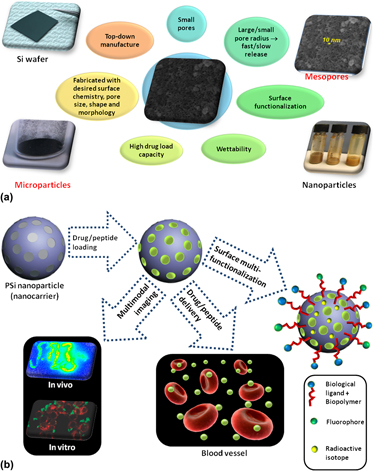Crossref Citations
This article has been cited by the following publications. This list is generated based on data provided by
Crossref.
Shahbazi, Mohammad-Ali
Herranz, Barbara
and
Santos, Hélder A.
2012.
Nanostructured porous Si-based nanoparticles for targeted drug delivery.
Biomatter,
Vol. 2,
Issue. 4,
p.
296.
Shahbazi, Mohammad-Ali
Hamidi, Mehrdad
Mäkilä, Ermei M.
Zhang, Hongbo
Almeida, Patrick V.
Kaasalainen, Martti
Salonen, Jarno J.
Hirvonen, Jouni T.
and
Santos, Hélder A.
2013.
The mechanisms of surface chemistry effects of mesoporous silicon nanoparticles on immunotoxicity and biocompatibility.
Biomaterials,
Vol. 34,
Issue. 31,
p.
7776.
Bimbo, Luis M.
Denisova, Oxana V.
Mäkilä, Ermei
Kaasalainen, Martti
De Brabander, Jef K.
Hirvonen, Jouni
Salonen, Jarno
Kakkola, Laura
Kainov, Denis
and
Santos, Hélder A.
2013.
Inhibition of Influenza A Virus Infection in Vitro by Saliphenylhalamide-Loaded Porous Silicon Nanoparticles.
ACS Nano,
Vol. 7,
Issue. 8,
p.
6884.
Santos, Hélder A.
Mäkilä, Ermei
Bimbo, Luis M.
Almeida, Patrick
and
Hirvonen, Jouni
2013.
Fundamentals of Pharmaceutical Nanoscience.
p.
235.
Hecini, Mouna
Khelifa, Abdellah
Bouzid, Bachir
Drouiche, Nadjib
Aoudj, Salaheddine
and
Hamitouche, Houria
2013.
Study of formation, stabilization and properties of porous silicon and porous silica.
Journal of Physics and Chemistry of Solids,
Vol. 74,
Issue. 9,
p.
1227.
Canham, Leigh
2014.
Handbook of Porous Silicon.
p.
733.
Canham, Leigh
2014.
Handbook of Porous Silicon.
p.
1.
Shahbazi, Mohammad-Ali
Almeida, Patrick V.
Mäkilä, Ermei M.
Kaasalainen, Martti H.
Salonen, Jarno J.
Hirvonen, Jouni T.
and
Santos, Hélder A.
2014.
Augmented cellular trafficking and endosomal escape of porous silicon nanoparticles via zwitterionic bilayer polymer surface engineering.
Biomaterials,
Vol. 35,
Issue. 26,
p.
7488.
Silvestre, Oscar F.
and
Chen, Xiaoyuan
2014.
Engineering in Translational Medicine.
p.
535.
Xia, Bing
Zhang, Wenyi
Shi, Jisen
and
Xiao, Shou-jun
2014.
A novel strategy to fabricate doxorubicin/bovine serum albumin/porous silicon nanocomposites with pH-triggered drug delivery for cancer therapy in vitro.
Journal of Materials Chemistry B,
Vol. 2,
Issue. 32,
p.
5280.
Xia, Bing
Wang, Bin
Shi, Jisen
Zhang, Wenyi
and
Xiao, Shou-jun
2014.
Engineering near-infrared fluorescent styrene-terminated porous silicon nanocomposites with bovine serum albumin encapsulation for in vivo imaging.
J. Mater. Chem. B,
Vol. 2,
Issue. 47,
p.
8314.
Liu, D.
Shahbazi, M.-A.
Bimbo, L.M.
Hirvonen, J.
and
Santos, H.A.
2014.
Porous Silicon for Biomedical Applications.
p.
129.
Almeida, Patrick V.
Shahbazi, Mohammad-Ali
Mäkilä, Ermei
Kaasalainen, Martti
Salonen, Jarno
Hirvonen, Jouni
and
Santos, Hélder A.
2014.
Amine-modified hyaluronic acid-functionalized porous silicon nanoparticles for targeting breast cancer tumors.
Nanoscale,
Vol. 6,
Issue. 17,
p.
10377.
Osminkina, Liubov A
Sivakov, Vladimir A
Mysov, Grigory A
Georgobiani, Veronika A
Natashina, Ulyana А
Talkenberg, Florian
Solovyev, Valery V
Kudryavtsev, Andrew A
and
Timoshenko, Victor Yu
2014.
Nanoparticles prepared from porous silicon nanowires for bio-imaging and sonodynamic therapy.
Nanoscale Research Letters,
Vol. 9,
Issue. 1,
Shahbazi, Mohammad-Ali
Fernández, Tahia D.
Mäkilä, Ermei M.
Le Guével, Xavier
Mayorga, Cristobalina
Kaasalainen, Martti H.
Salonen, Jarno J.
Hirvonen, Jouni T.
and
Santos, Hélder A.
2014.
Surface chemistry dependent immunostimulative potential of porous silicon nanoplatforms.
Biomaterials,
Vol. 35,
Issue. 33,
p.
9224.
Shahbazi, Mohammad‐Ali
Almeida, Patrick V.
Mäkilä, Ermei
Correia, Alexandra
Ferreira, Mónica P. A.
Kaasalainen, Martti
Salonen, Jarno
Hirvonen, Jouni
and
Santos, Hélder A.
2014.
Poly(methyl vinyl ether‐alt‐maleic acid)‐Functionalized Porous Silicon Nanoparticles for Enhanced Stability and Cellular Internalization.
Macromolecular Rapid Communications,
Vol. 35,
Issue. 6,
p.
624.
Tölli, Marja A.
Ferreira, Mónica P.A.
Kinnunen, Sini M.
Rysä, Jaana
Mäkilä, Ermei M.
Szabó, Zoltán
Serpi, Raisa E.
Ohukainen, Pauli J.
Välimäki, Mika J.
Correia, Alexandra M.R.
Salonen, Jarno J.
Hirvonen, Jouni T.
Ruskoaho, Heikki J.
and
Santos, Hélder A.
2014.
In vivo biocompatibility of porous silicon biomaterials for drug delivery to the heart.
Biomaterials,
Vol. 35,
Issue. 29,
p.
8394.
Santos, Hélder A
Mäkilä, Ermei
Airaksinen, Anu J
Bimbo, Luis M
and
Hirvonen, Jouni
2014.
Porous Silicon Nanoparticles for Nanomedicine: Preparation and Biomedical Applications.
Nanomedicine,
Vol. 9,
Issue. 4,
p.
535.
Shahbazi, Mohammad-Ali
Shrestha, Neha
Mäkilä, Ermei
Araújo, Francisca
Correia, Alexandra
Ramos, Tomás
Sarmento, Bruno
Salonen, Jarno
Hirvonen, Jouni
and
Santos, Hélder A.
2015.
A prospective cancer chemo-immunotherapy approach mediated by synergistic CD326 targeted porous silicon nanovectors.
Nano Research,
Vol. 8,
Issue. 5,
p.
1505.
Xia, Bing
Wang, Bin
Zhang, Wenyi
and
Shi, Jisen
2015.
High loading of doxorubicin into styrene-terminated porous silicon nanoparticles via π-stacking for cancer treatments in vitro.
RSC Advances,
Vol. 5,
Issue. 55,
p.
44660.



